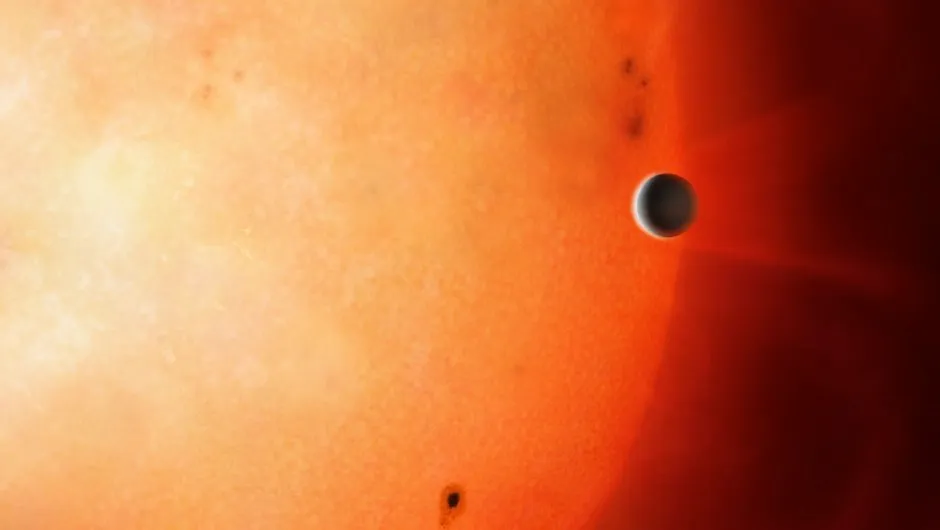- Exoplanet discovered with a year shorter than one Earth day.
- Orbits so rapidly because it is very close to its star – 27 times closer than Mercury is to our own Sun.
- Discovery could help us understand whether planets are in the process crashing into their suns.
Astronomers have observed an exoplanet orbiting a star in just over 18 hours – the shortest orbital period ever seen for a planet of its type.
This means that a single year for this hot Jupiter-like planet – a gas giant similar in size and composition to Jupiter in our own Solar System – passes in less than a day of Earth time.
Scientists believe the discovery may help solve the mystery of whether such planets are in the process of spiralling towards their suns to their destruction.
Read more about bizarre exoplanets:
The planet NGTS-10b was discovered around 1,000 light years away from Earth as part of the Next-Generation Transit Survey (NGTS).
The exoplanet survey, based in Chile, aims to discover planets down to the size of Neptune using the transit method.This involves observing stars for a telltale dip in brightness which indicates that a planet has passed in front of it.At any one time, the survey observes around 100,000 stars.

The star reported in the Monthly Notices of the Royal Astronomical Society caught the eye of astronomers from the University of Warwick due to frequent dips in its light caused by the planet’s rapid orbit.
Lead author Dr James McCormac, from the university’s department of physics, said: “We’re excited to announce the discovery of NGTS-10b, an extremely short period Jupiter-sized planet orbiting a star not too dissimilar from our Sun.
“We are also pleased that NGTS continues to push the boundaries in ground-based transiting exoplanet science through the discovery of rare classes of exoplanets.
"Although in theory, hot Jupiters with short orbital periods (less than 24 hours) are the easiest to detect due to their large size and frequent transits, they have proven to be extremely rare. Of the hundreds of hot Jupiters currently known, there are only seven that have an orbital period of less than one day.”
Researchers say the exoplanet orbits so rapidly because it is very close to its star – 27 times closer than Mercury is to our own Sun.They say it is perilously close to the point where tidal forces from the star would eventually tear the planet apart.
The planet is likely to be tidally locked so one side of the planet is constantly facing the star and constantly hot – with an estimated average temperature of more than 1,000°C.
Read more about searching for exoplanets:
The star itself is around 70 per cent the radius of the Sun and 1,000 degrees cooler.
Co-author Dr David Brown said: “It’s thought that these ultra-short planets migrate in from the outer reaches of their solar systems and are eventually consumed or disrupted by the star.”
Co-author Dr Daniel Bayliss said that, over the next decade, it might be possible to see this planet spiralling in.
NGTS is situated at the European Southern Observatory’s Paranal Observatory in the heart of the Atacama Desert in Chile.
Reader Q&A: What colour is the sky on an exoplanet?
Asked by: Alex Pacynko, Bristol
The colour of the sky on an exoplanet depends on many things: the pressure, density and chemical composition of its atmosphere, the presence or absence of dust particles, vapour and clouds, the spectrum of the planet’s parent star, as well as the size, composition, colour and even biology of the planet itself.
On Earth, the sky is predominantly blue but becomes orange or red near the setting or rising Sun. On Mars, the opposite is true.
These differences are mainly due to which compounds or gases are scattering and absorbing the sunlight. Scattering is the predominant factor in most atmospheres and since molecules scatter short wavelengths best and longer wavelengths the least well, this often results in blue skies.
But large amounts of dust will lighten and sometimes redden sky colours. Mars’ atmosphere appears red because of the presence of iron oxide-rich dust particles. High-pressure atmospheres would be much lighter than lower pressure ones and could appear completely white or yellow.
Given the number of factors involved it isn’t unreasonable to suppose that exoplanet skies could be any colour at all – from blue or cyan, through green and yellow to red, orange and purple – even brown and white are possible.
Read more: